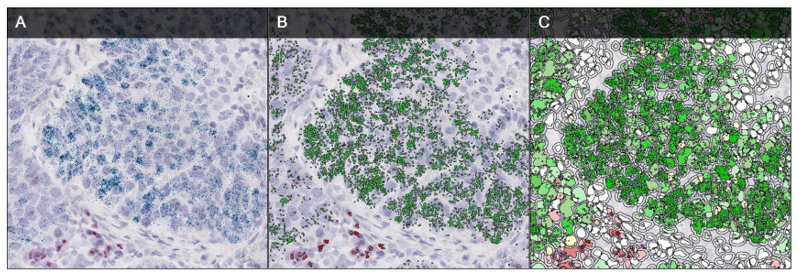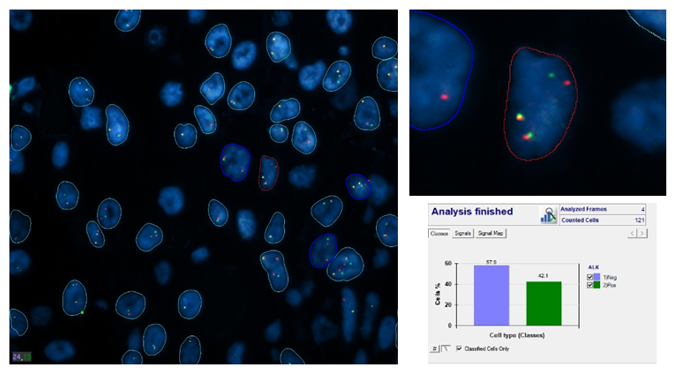- You are here: Home
- Services
- ISH/FISH Services
- Digital ISH Image Quantification and Statistical Analysis
Services
-
Cell Services
- Cell Line Authentication
- Cell Surface Marker Validation Service
-
Cell Line Testing and Assays
- Toxicology Assay
- Drug-Resistant Cell Models
- Cell Viability Assays
- Cell Proliferation Assays
- Cell Migration Assays
- Soft Agar Colony Formation Assay Service
- SRB Assay
- Cell Apoptosis Assays
- Cell Cycle Assays
- Cell Angiogenesis Assays
- DNA/RNA Extraction
- Custom Cell & Tissue Lysate Service
- Cellular Phosphorylation Assays
- Stability Testing
- Sterility Testing
- Endotoxin Detection and Removal
- Phagocytosis Assays
- Cell-Based Screening and Profiling Services
- 3D-Based Services
- Custom Cell Services
- Cell-based LNP Evaluation
-
Stem Cell Research
- iPSC Generation
- iPSC Characterization
-
iPSC Differentiation
- Neural Stem Cells Differentiation Service from iPSC
- Astrocyte Differentiation Service from iPSC
- Retinal Pigment Epithelium (RPE) Differentiation Service from iPSC
- Cardiomyocyte Differentiation Service from iPSC
- T Cell, NK Cell Differentiation Service from iPSC
- Hepatocyte Differentiation Service from iPSC
- Beta Cell Differentiation Service from iPSC
- Brain Organoid Differentiation Service from iPSC
- Cardiac Organoid Differentiation Service from iPSC
- Kidney Organoid Differentiation Service from iPSC
- GABAnergic Neuron Differentiation Service from iPSC
- Undifferentiated iPSC Detection
- iPSC Gene Editing
- iPSC Expanding Service
- MSC Services
- Stem Cell Assay Development and Screening
- Cell Immortalization
-
ISH/FISH Services
- In Situ Hybridization (ISH) & RNAscope Service
- Fluorescent In Situ Hybridization
- FISH Probe Design, Synthesis and Testing Service
-
FISH Applications
- Multicolor FISH (M-FISH) Analysis
- Chromosome Analysis of ES and iPS Cells
- RNA FISH in Plant Service
- Mouse Model and PDX Analysis (FISH)
- Cell Transplantation Analysis (FISH)
- In Situ Detection of CAR-T Cells & Oncolytic Viruses
- CAR-T/CAR-NK Target Assessment Service (ISH)
- ImmunoFISH Analysis (FISH+IHC)
- Splice Variant Analysis (FISH)
- Telomere Length Analysis (Q-FISH)
- Telomere Length Analysis (qPCR assay)
- FISH Analysis of Microorganisms
- Neoplasms FISH Analysis
- CARD-FISH for Environmental Microorganisms (FISH)
- FISH Quality Control Services
- QuantiGene Plex Assay
- Circulating Tumor Cell (CTC) FISH
- mtRNA Analysis (FISH)
- In Situ Detection of Chemokines/Cytokines
- In Situ Detection of Virus
- Transgene Mapping (FISH)
- Transgene Mapping (Locus Amplification & Sequencing)
- Stable Cell Line Genetic Stability Testing
- Genetic Stability Testing (Locus Amplification & Sequencing + ddPCR)
- Clonality Analysis Service (FISH)
- Karyotyping (G-banded) Service
- Animal Chromosome Analysis (G-banded) Service
- I-FISH Service
- AAV Biodistribution Analysis (RNA ISH)
- Molecular Karyotyping (aCGH)
- Droplet Digital PCR (ddPCR) Service
- Digital ISH Image Quantification and Statistical Analysis
- SCE (Sister Chromatid Exchange) Analysis
- Biosample Services
- Histology Services
- Exosome Research Services
- In Vitro DMPK Services
-
In Vivo DMPK Services
- Pharmacokinetic and Toxicokinetic
- PK/PD Biomarker Analysis
- Bioavailability and Bioequivalence
- Bioanalytical Package
- Metabolite Profiling and Identification
- In Vivo Toxicity Study
- Mass Balance, Excretion and Expired Air Collection
- Administration Routes and Biofluid Sampling
- Quantitative Tissue Distribution
- Target Tissue Exposure
- In Vivo Blood-Brain-Barrier Assay
- Drug Toxicity Services
Digital ISH Image Quantification and Statistical Analysis
In situ hybridization (ISH, CISH, FISH) is a popular approach for the evaluation of changes in biomarker expression or a particular drug response effect in tissues, especially in the case of novel biomarkers where robust, well validated antibodies are not commercially available. And investigating RNA at a single cell level can give important information about a cell’s dynamic gene expression. When analyzed in situ and in the context of the whole tissue, researchers can identify aberrant gene expression associated with disease states, such as cancer and neurological disease.
DNA FISH analysis is also available in Creative Bioarray include the FISH Amplification & Deletion Analysis module, used to quantify up to two fluorescently labeled DNA probes to measure amplification or deletion, and the FISH Break apart & Fusion Analysis module, used to measure gene rearrangements detected using break-apart fusion probes.
 Fig. 1 AN RNA ISH assay of a non-small-cell lung carcinoma, probed for the immune checkpoint markers PD-L1 (green) and CTLA4 (red) (A). Our system mark-up images are shown in (B) and (C) which visualize where the ISH module has detected probes (B) and where cells have been detected (C). Orange and red dots shown in (B) represent single and clusters of red probes, with the two shades of green dots representing the Expression of PDL-1 and T-lymphocytes identified by high levels of CTLA4 expression (red probe).
Fig. 1 AN RNA ISH assay of a non-small-cell lung carcinoma, probed for the immune checkpoint markers PD-L1 (green) and CTLA4 (red) (A). Our system mark-up images are shown in (B) and (C) which visualize where the ISH module has detected probes (B) and where cells have been detected (C). Orange and red dots shown in (B) represent single and clusters of red probes, with the two shades of green dots representing the Expression of PDL-1 and T-lymphocytes identified by high levels of CTLA4 expression (red probe).
 Fig 2. A DNA FISH assay for ALK translocation.
Fig 2. A DNA FISH assay for ALK translocation.
Benefits
- Receive highly detailed data quantifying RNA expression/DNA signals on a cell by cell basis across a whole tissue section or within defined regions of interest.
- Our automated batch analysis service objectively analyses each section using the same algorithm to reduce variability and improve data quality and interpretation.
Quotation and ordering
Our customer service representatives are available 24hr a day! We thank you for choosing Creative Bioarray at your preferred Digital ISH Image Quantification and Statistical Analysis.
Explore Other Options
For research use only. Not for any other purpose.

